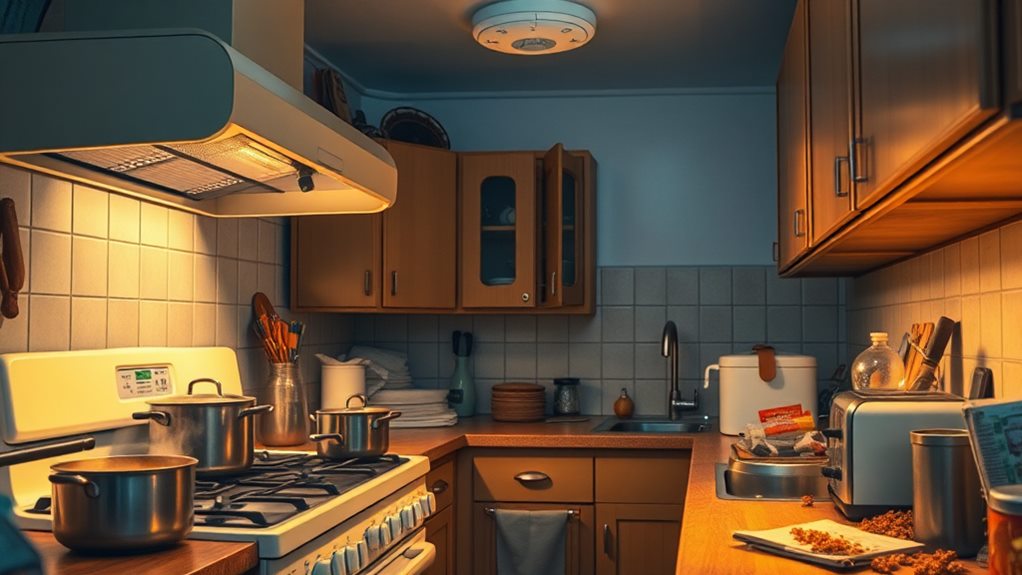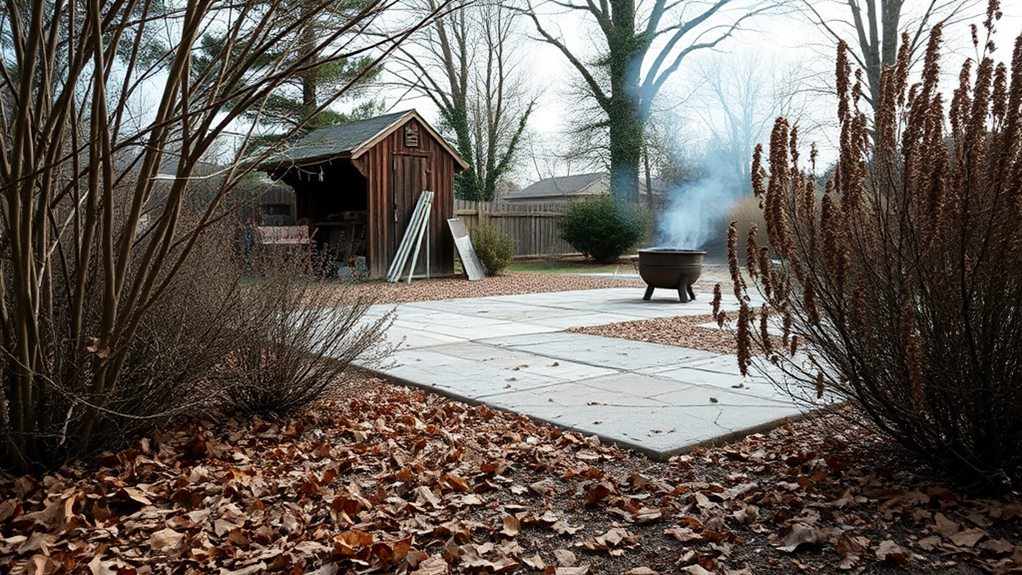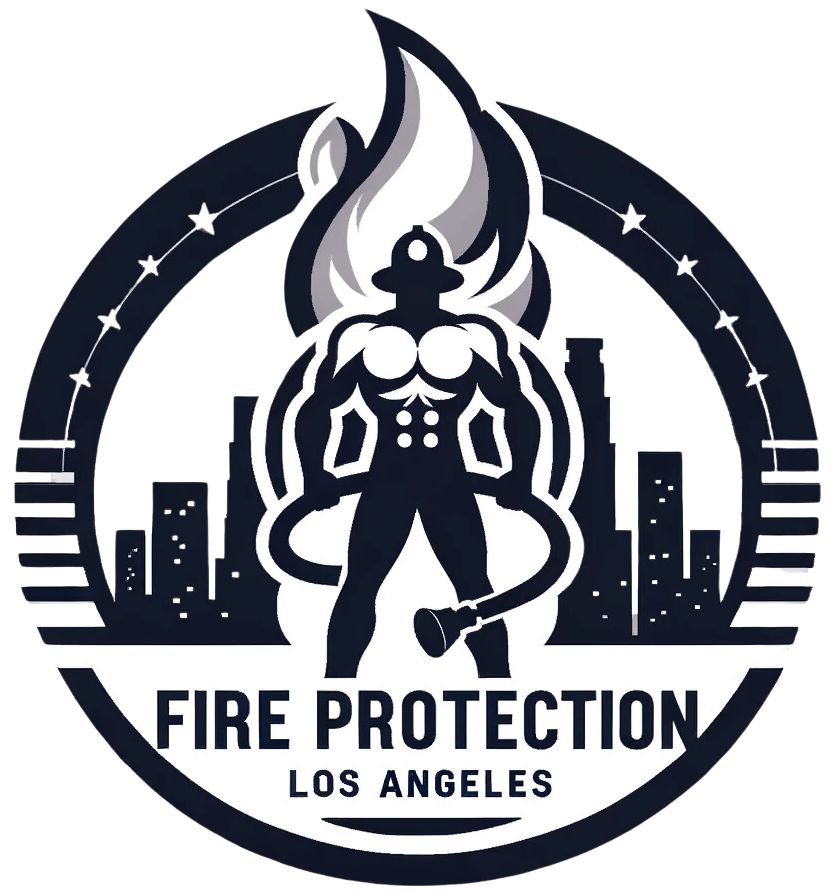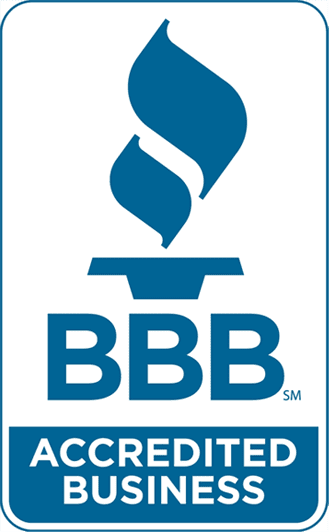To identify fire hazards in our home, we should start by checking the kitchen, as cooking causes nearly half of house fires. We need to keep stovetops clear and avoid leaving appliances unattended. Next, let's inspect electrical cords for damage and avoid overloading outlets. We should also declutter escape routes to guarantee safe exits during emergencies. Maintaining space around heating equipment is essential, and we must routinely check smoke alarms to confirm they work properly. By being vigilant and proactive, we can reduce risks considerably, and there's much more we can explore to enhance our home safety.
Kitchen Fire Risks

In the kitchen, where we often gather to prepare meals, fire risks lurk around every corner. Did you know that cooking incidents are responsible for nearly 50% of reported house fires? Stovetops are the primary source of these fires, especially when we leave them unattended.
Distractions can lead to overheating, which ignites nearby items, turning a simple meal into a disaster. It's essential to stay vigilant while cooking and to understand the importance of safe cooking practices to minimize risks.
Cluttered countertops also increase fire hazards. Flammable materials, like dish towels and paper products, can easily catch fire if they're too close to heat sources.
Regularly cleaning our cooking surfaces helps prevent grease buildup, which is another fire hazard we shouldn't overlook. Grease fires are particularly dangerous; water won't help them go out. Instead, we should use a lid to suffocate the flames or grab a fire extinguisher designed for grease fires.
Electrical Safety Checks
When it comes to electrical safety, we need to regularly inspect our electrical cords for any frays or damage, as these can lead to serious fire hazards.
Regular maintenance of fire safety equipment, including fire extinguishers, is vital to guarantee they function properly in case of an emergency, as highlighted in regular inspections.
It's also important to avoid overloading outlets, since using too many devices in one place can cause overheating.
Inspect Electrical Cords Regularly
Regular inspections of electrical cords are essential for maintaining a safe home environment. We should routinely inspect electrical cords for any signs of fraying, cracks, or damage, as regular checks can save lives.
Compromised cords can considerably increase the risk of electrical fires, which is something we all want to avoid. It's also important not to run extension cords under rugs or furniture; this can cause overheating and create serious fire hazards.
When we use electrical cords, we must follow manufacturer guidelines to prevent overloads and malfunctions. If we notice any damaged or worn cords, we should replace them immediately to reduce the risk of sparks and fires.
Additionally, let's keep our electrical outlets clean and clear. Loose connections can generate intense heat and may cause fires if we don't address them promptly.
Avoid Overloading Circuits
Overloading circuits is a common mistake that can lead to dangerous fire hazards in our homes.
It's crucial to understand how much power our appliances require and verify we don't exceed the electrical load for each circuit. When we plug multiple high-wattage devices into a single outlet, we risk overheating and potential fires.
Here are some important tips to help us avoid overloading circuits:
- Familiarize ourselves with the wattage ratings of our appliances to manage their usage effectively.
- Regularly inspect extension cords for damage, as frayed or cracked cords can cause electrical arcing, which poses serious fire hazards.
- Use power strips with built-in circuit breakers, offering extra protection against overloads.
Check Outlet Conditions
Electrical safety checks are essential for preventing fire hazards in our homes. One important area to focus on is our outlets. Regular inspections of outlets for signs of wear, such as scorch marks or loose connections, are vital as these can indicate potential fire risks.
Practical drills and safety plans enhance emergency response effectiveness, so it's also important to guarantee that everyone in the household is aware of these checks. If we see any damage, it's imperative to address it promptly.
To reduce the risk of overheating, we must remember to plug in no more than two devices into a single outlet. Overloading can lead to overheating and create a serious fire hazard. Additionally, we should avoid using extension cords as permanent solutions; they can also lead to increased fire risk.
Let's not forget to test our circuit breakers periodically. This simple action guarantees they're functioning properly and can prevent overloads that might cause fires.
If we notice flickering lights or unusual odors coming from our outlets, we should contact a professional electrician immediately. Faulty wiring can be dangerous, and it's better to be safe than sorry.
Clutter and Escape Routes

When we think about fire safety, it's essential to keep our escape routes clear and organized.
Clutter can block exits, making it harder for us to evacuate quickly in an emergency, so we should regularly declutter our homes.
Clear Pathways Importance
Maintaining clear pathways in our homes is essential for ensuring safe evacuation during a fire. When clutter blocks escape routes, it not only hinders our movement but also increases the risk of injury.
We must recognize that excessive clutter can easily ignite, creating additional fire hazards in emergencies.
To help us stay safe, here are three key points to remember about clear pathways:
- Keep exits and pathways unobstructed: The National Fire Protection Association (NFPA) highlights the importance of having clear escape routes during emergencies.
- Regularly declutter storage areas: This practice minimizes the accumulation of flammable materials, making escape routes accessible and safe.
- Organize our spaces: Reducing clutter enhances our overall fire safety, allowing us to exit swiftly if a fire occurs.
Clutter Reduction Strategies
A clutter-free home not only enhances our living space but also plays an essential role in fire safety. When we let clutter accumulate, it can obstruct escape routes, making it difficult to evacuate quickly during a fire emergency. That's why we must prioritize keeping pathways clear and exits free of stored belongings.
Regularly decluttering storage areas can greatly reduce fire hazards by minimizing the potential for flammable materials to pile up. By organizing items in designated storage spaces, we guarantee that important exits remain accessible at all times.
We can implement a systematic approach that allows us to evaluate what we truly need and what can be discarded or stored away safely.
Let's take time each month to assess our spaces and remove any unnecessary items. This not only enhances our safety but also creates a more enjoyable environment.
Heating Equipment Precautions
To keep our homes safe from fire hazards associated with heating equipment, we need to take some essential precautions. Heating equipment, especially space heaters, can pose significant fire risks if not used properly. By following these guidelines, we can reduce the chances of a dangerous situation.
- Maintain a minimum clearance of three feet around space heaters to keep them away from flammable materials.
- Always turn off space heaters when leaving a room or going to bed, as unattended fires are a common cause of heating-related incidents.
- Schedule annual chimney inspections and cleanings to prevent creosote buildup, which can lead to chimney fires.
Additionally, we should regularly inspect and maintain our heating equipment, particularly during the peak usage seasons from December to February.
Using appropriate fuel types for heating systems and storing portable generators outside is also vital to avoid harmful carbon monoxide buildup.
Outdoor Fire Hazards

Identifying outdoor fire hazards is essential for protecting our homes and loved ones. We can greatly reduce fire risks by maintaining a defensible space around our property. Clearing at least 30 feet of vegetation and debris is vital, as it lowers the amount of fuel for a potential fire.
Regularly inspecting and cleaning our gutters and roofs helps prevent the accumulation of leaves and debris, which can easily ignite during a fire. We should also position outdoor grills at least 10 feet away from any structures or flammable materials to minimize fire risks.
Another often-overlooked hazard is bird nests near outdoor lights. These nests can catch fire when they come into contact with heat, so it's important to regularly check for and remove them.
Additionally, we must keep overgrown vegetation, including shrubs and trees, trimmed back to at least 10 feet from our homes, as this distance decreases fire risks.
Smoke Alarm Maintenance
Regularly maintaining our smoke alarms is vital for guaranteeing our safety in the event of a fire.
Working smoke alarms can double our chances of survival, so we need to take this seriously. Here are some important steps we should follow:
- Test smoke alarms monthly to check if they're functioning correctly.
- Change the batteries in our smoke alarms at least every six months, ideally during daylight saving time for consistency.
- Replace smoke alarms every 10 years to keep up with safety standards and technology.
It's also important to install smoke alarms on every level of our home and inside each bedroom.
Some modern smoke alarms come with tamper-resistant features and sealed batteries that last for 10 years, which means we won't have to change the batteries regularly.
However, we still need to test them monthly to confirm they're working.
Final Thoughts
In our journey to make our homes safer, we've learned to spot fire hazards like a gardener tends to weeds in a garden. By checking our kitchens, ensuring electrical safety, and keeping escape routes clear, we nurture a safer environment. Just as a vigilant gardener protects their plants, we must maintain smoke alarms and be mindful of heating equipment. Together, let's cultivate safety, ensuring our homes thrive without the threat of fire lurking in the shadows.








